Many of my customers and students balk at the idea of putting a hooked rug on the floor. I reassure them that a well-made hooked rug will last 100 years or more, on the floor, and will in fact be fought over by future generations.
Stuff will happen to the rug, to be sure, but anything that happens to a hooked rug can be repaired (which is why they last so long). These rugs can be washed and vacuumed, and if they get stained, worn or moth-eaten, no worries, all these things can be fixed.
Vacuuming is great for hooked rugs, because you want to remove the grit that wears away at the fibers. Before I vacuum a hooked rug, I always check for snagged yarn to be re-hooked (more about this later). Don’t ‘beat’ a hooked rug though, that’s not good for the fibers.
Hooked rugs can also be washed, but hand-washing is preferred. Just have on hand two pans containing about two cups of water each. In the first, add one tablespoon of laundry detergent. (You want laundry detergent as opposed to dishwashing liquid or other soap, because you don’t want too many suds.)
Put a rag in the pan and squeeze it almost all the way out. You don’t need to get the rug soaking wet, you just want enough moisture to pick up the dirt that has been deposited on the rug. Scrub the rug in a circular motion. Don’t forget to wash the back as well.
In the second pan of water, add a splash of vinegar (this is good for the yarn). Then using a clean rag, go over the washed rug one more time, to remove some of the soap. Then lay the rug where it can get plenty of air to dry.
I read once that in days of yore, they would wait for a good powdery snow, take the rugs outside, put snow on top, sweep it off, and bring the rugs inside to dry. So you don’t need a lot of moisture, just enough to lift the dirt off the surface.
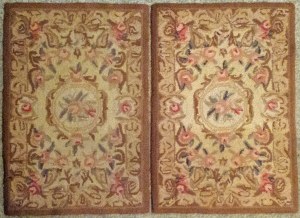
These two old rugs (above) were probably forty or fifty years old. They were quite dirty, but other than that, they were in really good shape. I washed them, and since the edges were in good shape, I decided to bind them before I use these rugs on the floor.
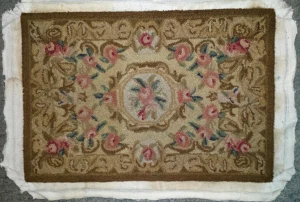
To bind the edge, I removed the hem, then I wrapped the backing around a cotton cord, extending out from the hooked edge. I tacked the cording in place using regular sewing thread.
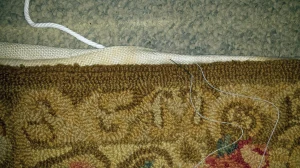
The cotton cord protects the backing, because the fabric is not going to fold down flat anymore.
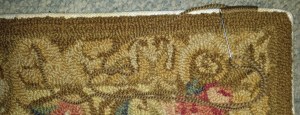
I whip stitch over the cording, using a matching yarn and a tapestry needle. I sew over the ends of the yarn, so they don’t show (I don’t tie knots in the back). The whip stitching adds yet another protective layer to the backing fabric, shielding it from wear and tear.
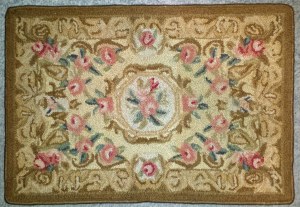
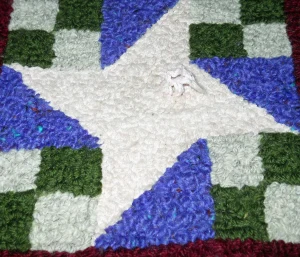
This is the most common thing that happens to a hooked rug. Occasionally, a bit of yarn may get snagged on something. Kitties are often the culprits, but don’t throw out the rug (or the cat!). Just remember, your rug will survive not only this cat, but many generations of family pets to come.

Just pull the unhooked yarn through to the back, and re-hook it. If you have just a little bit of experience with rug hooking, it is a five-minute repair. What could be easier?
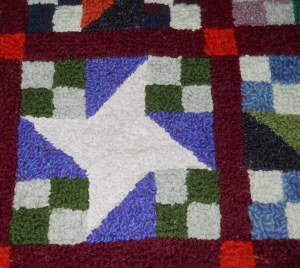
What if Fido took a liking to your hooked rug and decided to make it a chew toy, like the rug shown below?
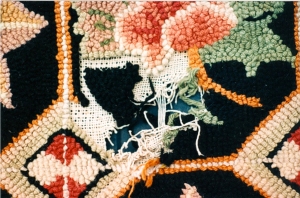
Don’t panic, even this can be repaired! Unhook the rug until you come to healthy backing. Then sew in a patch on the back. Tack the two layers of backing together, trimming away any loose threads, but keep the ones that run all the way through the damage. Then re-hook the rug, hooking through both layers.

This rug was fairly new at the time, so it was easy to match the yarn to re-hook the design. When you lay the rug on the floor, you cannot see the repair. If you examine it on the back, you can see the patch.
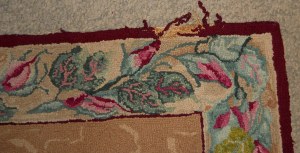
With normal wear and tear, the first place to wear out on a hooked rug is the edge. When I hook a rug, I always bind the edge to prevent such damage, but I have found that old rugs rarely have bound edges. In this instance, I unhooked the border and sewed in a patch to strengthen and protect the hooked edge of the rug. Then I re-hooked the border, bound the edge with a matching yarn, and completed the hem.


This Cocker Spaniel rug is another family treasure that had been used and loved for many decades. I unhooked the edge, but in this case, the owner decided to have me make the rug a little smaller, rather than patching the old edge.
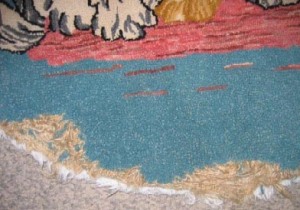
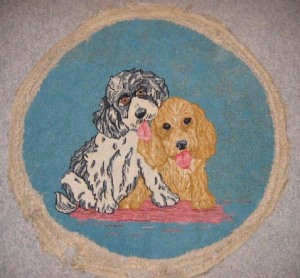
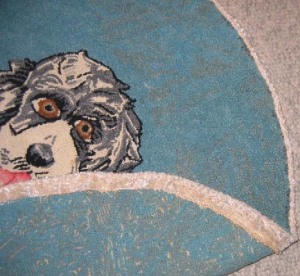
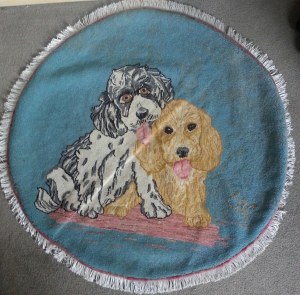
This charming leaf rug (below) had sustained major damage all around the edge, as well as in spots inside the design.
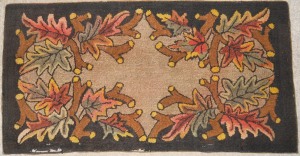
I made a large patch, to restore and support the entire edge. Then I re-hooked all of the patched areas and bound the edge, so the rug will continue to be used and enjoyed for a long time.
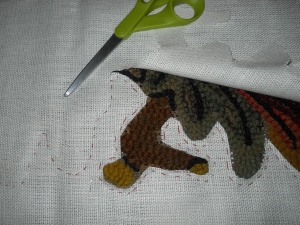
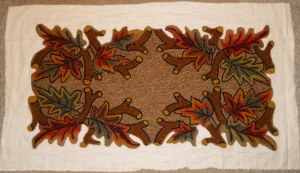
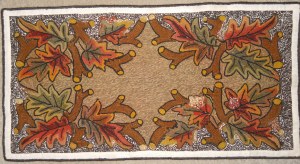
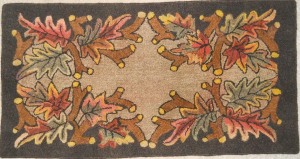
Why bother to repair an old rug? Because hooked rugs are extremely valuable. Restored, this rug has a retail value of at least $1400.00, not to mention the sentimental value to the family.
Don’t despair—REPAIR!!!
This month, subscribers to this blog can get my books for 20% off retail prices, and if you combine both Joy of Hooking (With Yarn!) and Rug Hooker’s Guide to the YARNIVERSE! you will save 35% off regular prices. This blog special will expire on July 31, 2015. http://hstrial-jtaylor9.homestead.com/blog-special-july-2015.html
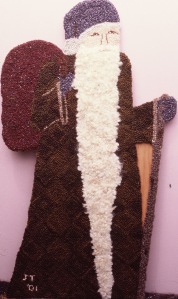
And don’t forget that for every $50.00 you spend with Little House Rugs between now and November 25, 2015, you will be entered to win the Victorian Santa (valued at $165.00). (In other words, if you spend $200.00 you will be entered four times.)
Happy Hooking!
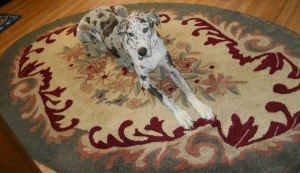
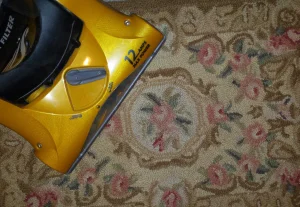
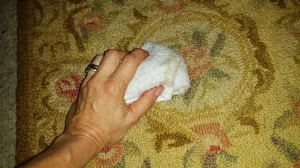
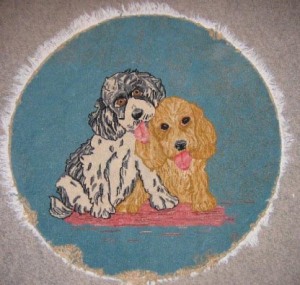
Val, I really enjoyed your cleaning and repair of hooked rugs information. The pictures of old rugs were great to see as well. Thank you for posting this!
LikeLike
Is there a person who will repair some damage to my mother’s hooked rugs? I don’t have the time to do it myself, but I would love to get the two of them repairs.
LikeLike
I do repair old rugs, best if you can send me some photos of the damage to get things started. You can email them to judytaylor@littlehouserugs.com
LikeLike
Thank you so much, Judy! (Is that a Catahoula leopard dog?)
LikeLike
Judy, thank you so much. I picked up a small hooked rug at the thrift store that needs the edges done and I am going to give it a try based on your great instructions. Where do you typically purchase materials for the repair.
LikeLike
It depends on what is needed. If the backing is in good condition and you just want to bind the edges, I buy the cotton cording from the fabric store (3/16″ in the upholstery section). If the backing needs repair, you can get cotton monks cloth at most fabric stores, or you can order cotton rug warp or linen from rug hooking companies (I usually try to use the same type of backing material as the original rug). Then the yarn comes from lots of places. If you are having trouble matching a color or texture, send me a sample of the color, I might be able to match it for you. Take pictures and consider sharing your repair story on my website Featured Rug of the Month at http://www.littlehouserugs.com.
LikeLike
Oh my goodness, your site is just what I needed to repair a rug that I made for my brother when I was in High school, That rug is now just about 50 years old. I was actually shocked that he even still had the thing when he asked me to fix it for him. The edge was damaged, backing torn and loops pull out.
I kind of made up my process as I am going along, but my plan exactly matches what you describe here.
One question. I was planning on applying a skid proof rubberized backing paint on the back of the rug. What do you think of doing such a thing?
LikeLike
I am so glad you’re able to fix the rug, but I don’t recommend putting the latex on the back. In the first place, it doesn’t keep the loops from pulling out, it just makes them impossible to fix when it does happen. Also, the backing is more likely to rot because of poor air circulation. If you want to prevent the rug from slipping on the floor, I would get one of those rubberized mats that you can cut to the size of the rug and lay it on that. If you go to my website, http://www.littlehouserugs.com, you can send me pictures of the repair job you’re doing, and I’ll share it on the site. Thanks!
LikeLike
Thank you for the advise. I see the wisdom of not putting the latex on the back. I decides to try to bind the edges as described above. I will post photos on the website as I go along.
LikeLike
Great! Keep me posted!
LikeLike
Please contact me on repairing my moms rug
LikeLike
Can you email me a picture? Send to judytaylor@littlehouserugs.com, thanks!
LikeLike
I purchased 2 large old hand hooked patteren rugs whicj I think were on the floor and are very dirty How can I clean them? email bev karlsson mendal0117@gmail.com thank you
LikeLike
sorry I dont know how to send pictures mendal0117#gmail.com
LikeLike
You can definitely clean your rugs, you might be surprised how much you can improve their appearance. To read more, go to https://wordpress.com/post/judytaylor2013.wordpress.com/133
LikeLike
If you have digital versions of your pics, you can attach them to an email, or if you have hard copies, you can mail them to me at http://www.littlehouserugs.com/Contact-Us.html. Thanks!
LikeLike
where are you located? I have a beautiful rug hooked by my mother-in-law and would like to have it repaired…I would need to get it to you if you think it can be repaired after I submit photo
LikeLike
If you go to my website, http://www.littlehouserugs.com, and go to Contact Us, you can reach me there. If you attach photos of the front and back, I can give you an estimate of what needs doing. Thanks!
LikeLike
Thanks for sharing the post. I really like the post
LikeLike
Wonderful suggestion. Keep up the good work. I really like the post
LikeLike
I have an old hooked footstool that looks dirty and faded. I took it apart and the underside looks vibrant. Is there a way to revive the colors of this old piece?
LikeLike
Probably not, sorry. Those soft colors are part of its value. Well-earned.
LikeLike
Can I send you my rug to repair?
LikeLike
Sure, just contact me through my website, http://www.littlehouserugs.com. You can send photos of the full rug, as well as close-ups of any damage. I’ll give you an idea of what I can do and how much it will cost. Thanks!
LikeLike
Hi. I have a small rug I made years ago, acrylic yarn. I’ve washed and repaired some snags. But overall, the knots are very loose. Should I go through and retighten them all, and if so, any suggestions on a good process? Thanks
LikeLike
Cathy:
If you’d like to email pictures of your rug, you can send them to littlehouserugs@hotmail.com. Then I might be able to advise you. Thanks!
LikeLike
Great website; you’ve given me inspiration to try and repair my hooked dining room rug. Sadly, we had some carpet beetles damage a patch the size of an orange. I have since cleaned thoroughly, vacuumed, and treated the area with a vinegar mixture. Any advice…to repair or part with it? It’s a 5×8 wool rug made 35 years ago in the Peoples Republic of China. I have two of them side by side under our dining room table (a room we don’t use but there were some storage boxes where the damage was done). Appreciate any advice.
LikeLike
Thanks for this resource! I just purchased one of the rugs in the same rose pattern as your twins. I tried the snow trick, but I’m not sure if the rug isn’t dirty or if the snow didn’t help. Given its age and the muddy colors, I’m guessing it is still dirty. Do you know anything about the history of that particular design?
LikeLike
Snow is good for lifting up the grit that builds up on the surface, but for a deeper clean, I use two pans of cold water. In one pan, I add a tablespoon of liquid laundry soap (less suds than dishwashing liquid), and in the other pan, I add a dash of white vinegar. With a clean rag in each pan, I go over the whole rug, once with the soapy water, following with the vinegar rinse. I squeeze the rags almost all the way out, to get at the dirt, but not to get the rug soaking wet. On a hot day, I can lay them out on a towel or sheet, where they’ll usually dry in a couple of hours. Inside in the winter, they may take a day or so to dry. Just flip them over a couple of times in the drying to get lots of air circulation.
LikeLike